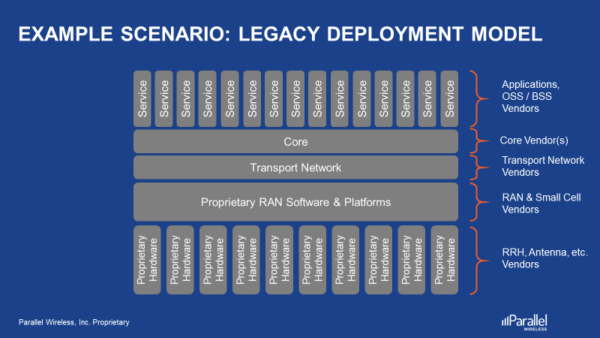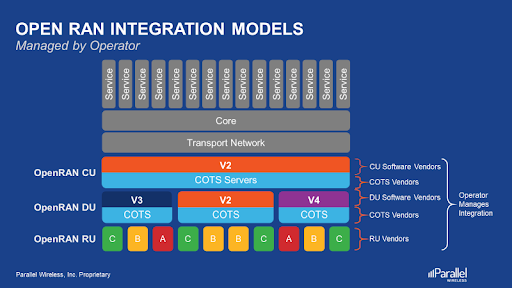Dispelling the Fear, Uncertainty and Doubt about Open RAN Integration
A question many people have with regard to Open RAN is: who would do all the integration between different Open RAN vendors – and with the incumbent vendors – in the network in the case of brownfield deployment? With more than 60 deployments and trials worldwide, we will explain based on our experience.
Let’s start with another basic illustration we have used before. In a traditional network, there are many different components and vendors. You have vendors for different kinds of applications, OSS/BSS vendors, one or more core network vendors, depending on the network configuration, many different vendors for transport networks, RAN and small cell vendors, RRH, antennas, etc. There are, of course, a lot more vendors not even listed here.

Service providers and mobile operators have to ensure that their networks continue to operate smoothly with all these different players in their network.
At a very high level, we can say that operators perform the following important tasks.
- Service Strategy – All operators have to focus on who they are targeting with their network, and how. This is generally the first step before the network is even launched and is also a continuous process as service providers must continuously re-evaluate their strategies.
- A mobile network cannot exist without spectrum, so the purchase of spectrum is another important task.
- Even before the spectrum has been purchased, operators must start evaluating vendors based on their strategy, vision and what spectrum they are likely to purchase. Once the spectrum has been purchased, they have to select vendors and purchase equipment.
- Then there are activities we refer to as “Network Business as Usual.” These are the tasks that go on continuously. These include: leasing and/or building sites; deploying and configuring equipment; optimization & drive testing of the deployed sites; maintenance to make sure all existing sites continue to work smoothly; fault management in case of issues; and, finally, upgrades which could be related to equipment, technology, backhaul, power, etc.
- One of the important but often-overlooked activities in a network is digital, sales & marketing. Any network has to make sure it’s appealing to different types of people, and this is where these activities play a big role.
- Billing & Operations ensures that end users are billed correctly and consistently so there is flow of money inwards. Operations covers a very wide area including order capture, order management, customer relationship management, inventory management, smooth operation of the network, etc.
- Finally, customer support is another key area. While many operators are transitioning from CSPs to DSPs, there is still a role for call center-based customer support services in addition to web support, support on social networks like Twitter and Facebook, chat support via sms, app or website, etc.
Having said this, as we discussed in our last Open RAN video, it is estimated that RAN is 60% of CAPEX and OPEX and, hence, the most important cost factor to focus on in telecom.
Going back to the high-level operator tasks, many operators outsource the task of leasing and/or building sites to Towercos and Infracos. These Towercos and Infracos could be pureplay independent companies or operator-led, as is becoming common nowadays. Similarly, when it comes to many of the Network Business as Usual tasks, many operators and service providers outsource these to a Managed Services company. It is estimated that around 80% of the mobile networks worldwide use a Managed Services Provider for some tasks. In fact, some of the incumbent network equipment vendors make most of their money by offering services in this way.
Coming back to our topic of Open RAN Integration, we can roughly say that there will be RU vendors, COTS vendors, and DU and CU Software vendors. A well-known incumbent network equipment vendor recently discussed the long-term cost issues associated with Open RAN. We will take their slide as a reference and try to separate fact from fiction.



Managed Services providers (MSPs) are experts in dealing with kits from various vendors. They have access to experienced people, which enables them to quickly grasp the basics of new technologies and continue providing their services without interruption. In addition, during the introduction phase, it is assumed that all vendors would be willing to provide insights about their products, thereby transferring the essential knowledge to MSP staff. Here as well, we believe the long-term costs for an operator would be far lower as compared to those of vendors selling proprietary kits and at the same time they will benefit from continuous innovation in the ecosystem.


So, this was a blog aimed at dispelling the FUD – or fear, uncertainty and doubt – about Open RAN integration. Having worked with many different operators in different parts of the world, we do not see it as an issue that will slow down Open RAN networks deployment or make an operator rethink their deployments.
If you’d like to learn more, contact us today.